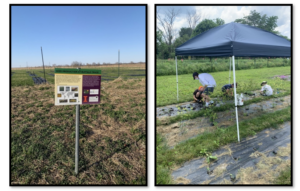Final report for GNC19-293
Project Information
Title: Applying ecological treatments to boost yields among restoration target species of seed production areas
Ecological restoration seeks to repair or assist the recovery of damaged or degraded ecosystems and yields benefits to society. Seed production areas (SPAs), which are plantings of wild plant species that apply agricultural and horticultural practices, are critical to supply these seeds for ecological restorations. SPA managers face challenges when cultivating wild plant species, leading to financial difficulties and unreliable seed supplies. Thus, restoration practitioners are commonly restricted by expensive or unavailable seed. SPA management techniques must be improved to boost seed yields to benefit stakeholders and facilitate ecological restorations. A common method to boost yields is to use chemical fertilizers similar to traditional agricultural techniques. Fertilizer addition has potential negative consequences such as nutrient runoff and promoting weed invasion, however. A promising technique is inoculation with arbuscular mycorrhizal fungi (AMF). AMF are soil fungi which associate with plant roots, providing water, nutrients, and pathogen defense in exchange for plant carbon. Recent studies suggest that soil inoculation with AMF could be an alternative and beneficial management technique that boosts plant growth. Yet, the value of AMF inoculation in commercial settings has not been evaluated.
To study SPA management, I will test nutrient addition and AMF inoculation strategies in experimental SPAs. Using a randomized block design, I will determine how the treatments affect seed yields and managerial input for three restoration species in two study sites across three growing seasons. Learning outcomes of the project include increasing knowledge of SPA management techniques, and generating awareness of the potential of AMF as a sustainable management strategy. Long-term action outcomes include implementation of production techniques which will increase seed yield in SPAs and provide a more reliable source of native plant seed for ecological restorations. I will evaluate the outcomes of this project by a combination of personal interaction with stakeholders at targeted conferences, as well as a follow-up survey of a technical report that I will send directly to producers in the native plant industry. My project will enhance the quality of life for SPA managers in the native plant industry, improve seed supplies imperative for restorations, and make this seed production more sustainable.
My outcomes will target stakeholders in the native plant nursery, particularly native seed producers. This project will create critical knowledge about SPA management techniques for native growers. Such knowledge would improve the abilities of managers to reliably produce their crop. Results could encourage native growers to boost yields using sustainable inoculation techniques rather than fertilizer addition. It will promote a greater awareness about the value of soil manipulation through arbuscular mycorrhizal fungal inoculation. My participating stakeholders will apply both methods to their experimental SPAs. Long-term action outcomes include implementation of production techniques which will increase seed yield in SPAs and provide a more reliable source of native plant seed for ecological restorations
Research
Introduction
To perform ecological restorations, many practitioners use revegetation to assist ecosystem recovery, particularly using seeds due their efficiency to revegetate areas (Brudvig 2011). Seed production areas (SPAs) are critical to supply these seeds for ecological restorations (Broadhurst et al. 2016). SPAs are plantings of wild species which are grown using agricultural and horticultural practices to maximize seed production (Broadhurst et al. 2016). They are considered a viable method to yield seed for restorations when wild seed sources are unavailable.
Despite the role of SPAs in ecological restoration, stakeholders in the native plant industry face severe business challenges. SPA managers have described rigorous labor requirements, poor managerial knowledge, and unreliable seed outputs of their native crops as major obstacles to efficient production (Jones and Young 2005). Likewise, institutional support for SPA managers is low and research regarding SPA management is scarce (Merrit and Dixon 2011). These obstacles can reverberate to other stakeholders. For example, prairie restorationists frequently claim that they are limited by inadequate seed availability and expensive seed prices (Rowe 2010). Restorations are also becoming larger in size and provoking seed shortages in restorations (Broadhurst et al. 2016). Hence, there is a substantial need to improve SPA management and yields (Merrit and Dixon 2011; Broadhurst et al. 2016).
Inoculation with indigenous arbuscular mycorrhizal fungi (AMF) is a promising management strategy to improve SPA yields. AMF are a broad group of soil fungi which penetrate plant roots and generally provide nutrients and water in exchange for an energy source (Berruti et al. 2016). The AMF relationship can benefit a plant by enhancing the plant’s resource acquisition, buffering it from stresses (e.g., drought and herbivory), and even defending against soil pathogens (Berruti et al. 2016). Recent evidence suggests that many restoration target species have substantial growth benefits when they associate with AMF inocula that are indigenous to prairies in experimental settings (Koziol and Bever 2017; Bauer et al. 2017). AMF inoculum was found to improve survival of planted plugs and promote early flowering of prairie restoration target species (Koziol and Bever 2017). Although the positive potential of AMF inoculation to SPAs has been identified, its value in commercial settings has yet to be evaluated.
Alternatively, SPA managers could apply chemical fertilizers to boost SPA yields, which is often done in the industry (Dunne and Dunne 2003). However, fertilizers may be a poor management choice in SPAs. Fertilizer may not be conducive to the ecology of many native target crops. Many SPA crops are slow growing and have growth traits less suited for the quick acquisition of labile soil nutrients (Bauer et al. 2017), in contrast to traditional agricultural species.
For SARE GNC19-293, I created experimental SPAs which tested the effects of AMF inoculation and fertilizer addition as management strategies. This report presents final results of the project, including descriptions of the project’s methods, outreach, and future.
Methods
Field site descriptions
Three sites were used for the project, representing different stakeholders for SPAs (Fig. 1): Barefoot Nursery & Restoration (Springfield, IL, and hereafter, “Barefoot”), Heritage (Champaign, IL, and hereafter, “Heritage”), and Lake of the Woods Forest Preserve (Mahomet, IL, and hereafter, “LOTW”). These locations represent a private enterprise, a local organization, and a regional conservation organization, respectively.
Figure 1: Locations of the three field sites of experimental SPAs in Illinois.
Barefoot is a private nursery which specializes in native plants, including existing plots for seed production. The site consists of small-scale infrastructure for growing and producing seed mixes. The SPA at this site was established on a 1-acre section of a corn-soy farm field, which was adjacent to the nursery. Soils at the site range from sandy loam to pure sand due to historical deposition from the nearby Sangamon River. Thus, some sections in the SPA appear unusually nutrient-poor, as well as prone to heating and desiccation. The Heritage location is former turf grass managed by the Champaign Park District. The site is marginal property for the Park District, with low pedestrian and recreational traffic. The site is flanked by a prairie restoration to the east, and Copper Slough to the west. The soils are Drummer silty clay loam and have a low weed seed bank. Growing conditions at Heritage seem the least stressful (e.g., high quality soil, high water retention). LOTW is a nature preserve managed by the Champaign County Forest Preserve District (CCFPD), consisting of a matrix of woodland, prairie, and savanna habitats. The SPA was established on an acre of old field adjacent to the popular Buffalo Trace Bike Trail. Previously, the site was dominated by Bromus inermis (smooth brome), Trifolium pratense (red clover), and ruderal species. Soils at the SPA are Dana silt loam and appear to be of intermediate growing quality when compared to Barefoot and Heritage.
SPA preparation and experimental design
SPAs were established in early April 2020 by using 4’ Dewitt Sunbelt weed barrier fabric to smother existing vegetation (Fig. 2).
Figure 2: The dimensions and experimental design of the SPAs at the three sites. A) A visual representation of the dimensions of each block and its components. B) An example of the experimental design, showing randomized treatments within two example blocks. Each block has randomized positioning of the study species within each row.
Experimental SPAs were created using a randomized block design, with a 2x2 factorial treatment combination, with AMF inoculation and fertilizer addition as treatments (Fig. 2). Each block was 32 ft x 43 ft and consisted of 4 25-ft rows. To prevent treatment spillover, buffers between each row were 6 ft; buffers between rows within blocks were 7 ft (Fig. 2A). Buffers were seeded with turfgrass at Barefoot and LOTW due to the lack of suitable vegetation at these sites.
Study species descriptions, cultivation, and field transfer
I chose four study species: Asclepias tuberosa (butterfly weed), Echinacea pallida (pale purple coneflower), Eryngium yuccifolium (rattlesnake master), and Parthenium integrifolium (wild quinine). These species were selected because 1) they are herbaceous flowering target species in restorations and are valuable for use in USDA programs such as the Conservation Reserve Program and CP-42 pollinator plantings (National Conservation Practice Standards 2015), 2) they were also previously shown to have positive growth responses to indigenous AMF treatments in experimental settings (Koziol et al. 2017).
I purchased seed of the four study species in January 2020, from Prairie Moon Nursery (Winona, MN). Prairie Moon Nursery sells sourced seed (i.e., local ecotype) from a network of producers throughout the Midwest. All seed was cold moist stratified in double-sterilized sand for 60 days.
I applied the nurse plant method for inoculation. This method pre-infects seedlings or plugs prior to field establishment, which can boost inoculum survival and have infected plants act as nuclei to nearby plants (Koziol et al. 2017). In late March 2020, seeds were sown into flats containing a mixture of 50-50 sand and general-purpose soil mix (1:1:1 soil/peat/perlite), which was double sterilized using steaming. There were one to two rest days in between each sterilization event. After germination and the appearance of cotyledons, seedlings were transferred to 72-cell growing trays. Thereafter, for all the study species, half of seedlings were put into -AMF growing trays (60-40 double-sterilized sand/potting soil mixture), while the other half were transferred to +AMF growing trays. +AMF growing trays consisted of 45-45 double sterilized sand/potting soil mixture, and 10% by volume of MycoBloom AMF. 10% of AMF mixture by volume is considered a liberal volume by MycoBloom instructions. I used the 50-50 sand/potting soil mixture as the base in growing trays in order to increase nutrient stress to promote +AMF seedling inoculation. Because AMF infection occurs over 2 weeks, seedlings were grown for 4-6 weeks before field transfer to promote root infection. Seedlings were grown in temperature-controlled conditions (24°C) at the University of Illinois Agricultural and Consumer Sciences Plant Care Facility (40° 6' 7" N, 88° 13' 26" W).
Most plugs were planted in-field between late April through June in Heritage and LOTW. Plugs were planted in late June and early July at Barefoot to allow the grass seed in the buffers to stabilize the soil. At each site, a particular species was always planted on a single day to minimize priority effects. Dead seedlings were replaced within 2 weeks of the initial establishment to have more complete rows, while avoiding substantial time elapsed to lead to priority effects. In each row, 6 plugs of each species were planted per row, totaling 24 plants per row across the four study species. Plugs were planted by staggering at a 1.4-ft distance (Fig. 2A); plants were staggered to avoid overcutting the center of the fabric. The fabric was cut by a 15-cm “X” in the plastic to transfer the plugs.
Field management
Throughout the growing season from 2020-2022, buffers within the blocks were mown biweekly. Rows were weeded as needed, generally monthly for Heritage and Barefoot, and once every three weeks for LOTW. During each growing season from 2020-2022, I conducted monthly fertilization treatments across all +nutrient rows in the three sites. The fertilizer used was Peters Excel 15-5-15 (NPK) fertilizer; a high N:P ratio was sought out because P fertilization is less important with respect to seed production (Ken Fromm, personal communication). Fertilization treatments consisted of adding 350 mL at 125 ppm (N) concentration to each individual plant within the +fertilizer.
Data collection and analysis
At each site, I determined each individual plant’s survival, flowering status, and relative size (Fig. 3). Size was assessed by measuring a plant’s height and its estimated leaf area. For each plant, leaves were subjectively counted as “small,” “medium,” or “large” based on the species. For each species, I estimated the area of each size class by averaging twenty samples of each species-leaf size combination. Leaf size class counts were then multiplied by the calculated average, and then summed for each plant. Apart from A. tuberosa, the seed was hand-harvested by row. A. tuberosa seed was not collected during the experiment because, across all three years and the three sites, there were nearly no viable seed pods through the duration of the experiment. For plant size estimators and seed yield, I averaged the values across species and within rows, yielding mean per capita leaf area and seed mass produced for each row, per block.
Figure 3: Data collection at Heritage during fall, 2020.
I used linear mixed effects models to assess treatment effects on mean leaf area and seed production. Seed production was log+1 transformed, and leaf area (cm2) was log-transformed. Fixed effects were nutrient and AMF treatment, sampling year, and the interaction of nutrient and AMF treatments. Random effects were site and block nested within site. All data analyses were conducted using R v. 4.0.2 (R Core Team 2020). Linear mixed effects models were constructed using the packages lme4 (Bates et al. 2015). All combinations of fixed effects were tested using the MuMIn package using the dredge() function from MuMIn (Bartoń 2022). I compared models that were fit with maximum likelihood using AICc. I used this procedure for each species individually for per capita seed yield (apart from A. tuberosa) and estimated plant size. For seed yields, I also excluded rows that did not produce seed (i.e., log+1 per capita mass = 0) because those data led to unsuitable model fit.
Results (note, results are still subject to change before formal publication)
Across the three sites, a total of 2,304 plugs were planted, representing 576 plugs of each species. Plug survival and size varied across years and species (Fig. 4). At the end of the experiment, 74% of plugs survived total; survival was highest for P. integrifolium (80%), and lowest for E. yuccifolium (68%). At the end of the experiment, plug survival was lowest at the LOTW site (60%), ostensibly because of intense herbivory throughout the experiment, which made assessing plant survival ambiguous (see P. integrifolium between years 2020-2022). Despite the stressful conditions of the Barefoot site, and smallest plant sizes (Fig. 4), it had the highest survival (87%).
Figure 4: Counted plug survival during the experiment organized by site, year, and planted species. Note that survival may have increased in some cases when plants were dormant and presumed dead at the time of counting.
Figure 5: Per capita seed yields of organized by the species Echinacea pallida (A), Eryngium yuccifolium (B), and Parthenium integrifolium. For each species, year and color-coded treatment rows are shown. Note that because E. yuccifolium did not produce seed in 2020, data are only shown for 2021-2022.
Across all three species, rows with nutrient and AMF treatments generally had similar or greater per capita yields than the controls (Fig. 5). Model coefficients for nutrient and AMF treatments for the three species were always greater than zero. Nutrient and AMF treated rows tended to have higher yields in both E. pallida and P. integrifolium (Fig. 5A; 5B). Year was always included in the best three models for per capita seed yields in each species (Table 1). Although the results were variable, and treatments never had overwhelming support, all the best supported models included at least one treatment effect, and models with year and treatment effects outperformed null models (Table 1). For E. pallida, the best supported model included year, AMF treatment, and nutrient treatment (weight = 0.42); for E. yuccifolium, the best supported model included year and nutrient treatment (weight = 0.38); for P. integrifolium, the best supported model included year and AMF treatment (weight = 0.41). When AICc weights of the treatment terms were summed per species, the AMF treatments had strong support in P. integrifolium (weight = 0.71) and E. pallida (weight = 0.66), and the nutrient treatment had strong support in E. pallida (weight = 0.83).
Table 1: Model selection results to explain per capita seed yields greater than zero across the three seed-producing species. Note that each model includes site and block nested within site random effects. For the model column, “M” corresponds to AMF treatment, “N” corresponds to fertilizer treatment, and “N:M” is the interaction between AMF and nutrient treatments. For brevity, only the three best supported models are shown for each species.
|
Species |
Model (Yield ~) |
df |
ΔAICc |
weight |
|
Echinacea pallida |
Year + M + N |
8 |
0 |
0.42 |
|
Year + N |
7 |
0.9 |
0.27 |
|
|
Year + M + N + N:M |
9 |
2.2 |
0.14 |
|
|
Eryngium yuccifolium |
Year + N |
6 |
0 |
0.38 |
|
Year |
5 |
0.3 |
0.33 |
|
|
Year + M + N |
8 |
2.1 |
0.13 |
|
|
Parthenium integrifolium |
Year + M |
7 |
0 |
0.41 |
|
Year + M + N |
8 |
1.3 |
0.22 |
|
|
Year |
6 |
1.5 |
0.19 |
For plant size, the results were similar to per capita seed yields. Generally, year was a strong fixed effect and was always indicated as better than null models. Moreover, the best supported models included treatment effects, though the strength of support and direction of impact varied by species (Table 2; Figs. 6-7). For A. tuberosa, AMF and nutrient treatment generally led to greater per capita plant size relative to controls (Fig. 6A). The best supported model for A. tuberosa included year and both nutrient and AMF treatment (weight = 0.41). When AICc weights of the treatment terms were summed for A. tuberosa, nutrients had strong support (weight = 0.85), and AMF treatment had weaker but also strong support (weight = 0.64). For E. pallida, the best supported model included year and nutrient treatment (weight = 0.40); for this species, nutrient treatments had an overall slightly positive influence on per capita leaf area, whereas AMF treatments were associated with slightly smaller sizes (coefficient = -0.05; see Fig. 6B). However, AMF treatment had lower support (weight = 0.36) compared to nutrients (weight = 0.66). For E. yuccifolium, the best model included year and AMF treatment (weight = 0.33). AMF had particularly strong support to be included (weight = 0.79). Surprisingly, for E. yuccifolium, nutrient treatments were associated with smaller sizes relative to controls (Fig. 7A), even though nutrients had positive impacts on per capita yields. For P. integrifolium, the best model included year and nutrient treatment (weight = 0.32); furthermore, nutrient treatment had modest support (weight = 0.63). AMF and nutrient treatments were associated with greater per capita plant sizes for P. integrifolium (Fig. 7B).
Figure 6: Per capita plant size based on estimated leaf areas for Asclepias tuberosa (A) and Echinacea pallida (B).
Figure 7: Per capita plant size based on estimated leaf areas for Eryngium yuccifolium (A) and Parthenium integrifolium (B).
Table 2: Model selection results for plant size using estimated leaf size as a proxy. Note that each model includes site and block nested within site random effects. For the model column, “M” corresponds to AMF treatment, “N” corresponds to fertilizer treatment, and “N:M” is the interaction between AMF and nutrient treatments. For brevity, only the three best supported models are shown for each species.
|
Species |
Model (Yield ~) |
df |
ΔAICc |
weight |
|
Asclepias tuberosa |
Year + M + N |
8 |
0 |
0.41 |
|
Year + N |
7 |
0.7 |
0.30 |
|
|
Year + M + N + N:M |
9 |
2.1 |
0.14 |
|
|
Echinacea pallida |
Year + N |
7 |
0 |
0.40 |
|
Year |
6 |
1.0 |
0.24 |
|
|
Year + M + N |
8 |
1.8 |
0.16 |
|
|
Eryngium yuccifolium |
Year + M |
7 |
0 |
0.33 |
|
Year + M + N + N:M |
9 |
0.1 |
0.32 |
|
|
Year + M + N |
8 |
1.5 |
0.15 |
|
|
Parthenium integrifolium |
Year + N |
7 |
0 |
0.32 |
|
Year + M + N |
8 |
0.7 |
0.22 |
|
|
Year + M + N |
6 |
0.7 |
0.22 |
Across all sites and years, approximately 250lbs of raw seed mass was harvested, which was estimated to yield nearly 130lbs of pure seed, with a retail market value of around $20,000 (Table 3). For some species, total seed yields declined during 2022 (e.g., E. pallida and P. integrifolium at Heritage); this was probably a combination of continued mortality of plants and 2022 being a drought year for east-central Illinois. Heritage produced the greatest yields and seed market value, matching the overall observation of high survival, the most vigorous growth, and low herbivory at this site. In contrast, the Barefoot site produced only $1,000 in seed during the experiment due to harsh conditions (dry, sandy soil, some shading effects of nearby woodland).
Table 3: Prices of seed yields for practitioners, organized by site, year, and species. Prices were inferred from a database of J. Zinnen that took average seed prices of the three listed study species from Midwestern native plant nurseries.
|
Site |
Year |
Species |
Yield ($) seed |
|
Barefoot |
2020 |
Echinacea pallida |
$0 |
|
Eryngium yuccifolium |
$0 |
||
|
Parthenium integrifolium |
$0 |
||
|
|
2020 total: $0 |
||
|
2021 |
Echinacea pallida |
$0 |
|
|
Eryngium yuccifolium |
$100 |
||
|
Parthenium integrifolium |
$200 |
||
|
|
2021 total: $300 |
||
|
2022 |
Echinacea pallida |
$200 |
|
|
Eryngium yuccifolium |
$300 |
||
|
Parthenium integrifolium |
$200 |
||
|
|
|
2022 total: $700 |
|
|
|
|
Site grand total: $1,000
|
|
|
Heritage |
2020 |
Echinacea pallida |
$0 |
|
Eryngium yuccifolium |
$0 |
||
|
Parthenium integrifolium |
$800 |
||
|
|
2020 total: $800 |
||
|
2021 |
Echinacea pallida |
$1,600 |
|
|
Eryngium yuccifolium |
$1,300 |
||
|
Parthenium integrifolium |
$3,800 |
||
|
|
2021 total: $6,700 |
||
|
2022 |
Echinacea pallida |
$1,000 |
|
|
Eryngium yuccifolium |
$2,100 |
||
|
Parthenium integrifolium |
$1,600 |
||
|
|
2022 total: $4,700 |
||
|
|
|
Site grand total: $12,200
|
|
|
Lake of the Woods |
2020 |
Echinacea pallida |
$0 |
|
Eryngium yuccifolium |
$0 |
||
|
Parthenium integrifolium |
$200 |
||
|
|
2020 total: $200 |
||
|
2021 |
Echinacea pallida |
$1,600 |
|
|
Eryngium yuccifolium |
$1,100 |
||
|
Parthenium integrifolium |
$1,300 |
||
|
|
2021 total: $4,000 |
||
|
2022 |
Echinacea pallida |
$600 |
|
|
Eryngium yuccifolium |
$1,400 |
||
|
Parthenium integrifolium |
$1,400 |
||
|
|
2022 total: $3,400 |
||
|
|
|
|
Site grand total: $7,600
|
|
|
|
|
Grand total for experiment: $20,800 |
Discussion
I found some evidence that AMF and nutrient treatments can improve outcomes relevant to SPA managers. These treatments could increase plant size and seed yields per plant—yet, treatment effects were not necessarily strong (Figs. 5-7), and the impact of some species-treatment combinations were modest. My results also suggest that site context (e.g., poor soil at Barefoot, deer and small mammal traffic at LOTW) may be more influential to outcomes than specific managerial practices.
This research highlights trade-offs in SPA management practices. Nutrient addition had modest support and increased per capita plant size and seed yields. Fertilizing is one basic SPA practice (e.g., Dunne and Dunne 2003), so these results were not unexpected. However, the ambiguity of nutrient effects in some species, as well as visibly weak effects on average, implies that it may be an inefficient management practice. Indeed, I conducted monthly fertilization treatments across three growing seasons, representing substantial time and material inputs. AMF treatments were generally, but not always, associated with increased plant size and seed yields. However, plug inoculation occurs before field transfer as a single treatment event, with only a small amount of AMF material needed per tray of plugs. Thus, even if AMF treatment effects were not as consistent or strongly supported compared to fertilization, it may be a viable “bet hedging” management option.
References
Bartoń K. 2022. MuMIn: multi-model inference. R package version 1.46.0. https://CRAN.R-project.org/package=MuMIn.
Bates D., Maechler M., Bolker B., Walker S. 2015. Fitting linear mixed-effects models using lme4. Journal of Statistical Software 67: 1-48.
Bauer J.T., Koziol L., Bever J.D. 2017. Ecology of Floristic Quality Assessment: testing for correlations between coefficients of conservatism, species traits, and mycorrhizal responsiveness. AoB Plants: plx073.
Berruti A., Lumini E., Balestrini R., et al. 2016. Arbuscular mycorrhizal fungi as natural biofertilizers: Let’s benefit from past successes. Frontiers in Microbiology 6: 1559.
Broadhurst L.M., Jones T.A., Smith F.S., et al. 2016. Maximizing seed resources for restoration in an uncertain future. BioScience 66: 73-79.
Brudvig L.A. 2011. The restoration of biodiversity: Where has research been and where does it need to go? American Journal of Botany 98: 549-558.
Dunne R.A., Dunne C.G. 2003. Trends in the Western native plant industry since 1990. Native Plants Journal 4: 88-94.
Gibson-Roy P. 2018. Restoring grassy ecosystems- Feasible or fiction? An inquisitive Australian’s experience in the USA. Ecological Management and Restoration 19: 11-25.
Gibson-Roy P., McLean C., Delpratt J.C., Moore G. 2014. Do arbuscular mycorrhizal fungi recolonize revegetated grasslands? Ecological Management and Restoration 15: 87-91.
Jones T.A., Young S.A. 2005. Native seeds in commerce: More frequently asked questions. Native Plants Journal 6: 286-293.
National Conservation Practice Standards. 2015. Conservation cover (Ac.): Code 327. (http://www.gfseedco.com/uploads/3/4/9/2/34921431/conservation_cover_il327_october_2015_final.pdf)
Koziol L., Schultz P.A., Bever J.D., et al. 2017. User Manual: A practical guide to inoculation with arbuscular mycorrhizal fungi in ecological restoration. SERDP Project RC-2330.
Merrit D.J., Dixon K.W. 2011. Restoration seed banks—A matter of scale. Science 332: 424-425.
R Core Team. 2020. R: A language and environment for statistical computing. R Foundation for Statistical Computing, Vienna, Austria. URL https://www.R-project.org/.
Rowe H.I. 2010. Tricks of the trade: Techniques and opinions from 38 experts in tallgrass prairie restoration. Restoration Ecology 18: 253-262.
Wyatt R. 1976. Pollination and fruit-set in Asclepias: a reappraisal. American Journal of Botany 63: 845-851.
Zinnen J., Broadhurst L.M., Gibson-Roy P., Jones T.A., Matthews J.W. 2021. Seed production areas are crucial to conservation outcomes: benefits and risks of an emerging restoration tool. Biodiversity and Conservation 5: 1233–1256.
Educational & Outreach Activities
Participation Summary:
At the start of the project, I contacted the Champaign County Forest Preserve District about establishing a SPA with both research plots and volunteer plots. I specifically sought to create the SPA at LOTW near the Buffalo Trace Prairie Bike Trail to expose the public to SPAs; an interpretive sign was installed at the site (Fig. 8). During the 2020-2022 field seasons, I spoke to dozens of park patrons about SPAs. I led two field days working with the Boy Scouts of America to plant additional plants at the LOTW site in 2020 and 2021; I spoke to the youth about seed production areas, scientific methods, and prairie restoration broadly. I presented some of the results of my activities at the 2021 Annual Meeting – SER Midwest-Great Lakes Chapter. I am currently working with the University of Illinois Extension to produce a handout to contact stakeholders directly about creating and managing SPAs.
Figure 8: Outreach and education at the LOTW SPA.
Project Outcomes
This project has identified two management practices that could increase yields in SPAs. Such strategies are critical to improve the supply chain of the native seed industry, which provides the raw materials necessary for ecological restoration in the region. This research adds to the growing body of evidence that native arbuscular mycorrhizal fungi could be important but underutilized tools for ecological restoration and environmental remediation. Increased seed yields create greater financial rewards for producers and can be accomplished with simple, straightforward management practices.
Additionally, the project will also continue to make local impacts to restoration stakeholders in east-central Illinois. Although the experimental component of the project ended in Fall 2022, I and the stakeholders will continue using the SPAs in the future. I am currently in discussions with the managers of the Heritage and LOTW sites to continue managing the SPAs, increasing production, and recruiting volunteers to assist with management next year.
Broadly, these results suggest that either AMF or mycorrhizal inoculation can situationally increase plant size, and more importantly, seed yields, in managed SPAs. The results from three field seasons suggest that year effects, individual plant performance, and local site contexts could overshadow SPA treatments. The project has also revealed several management challenges of using SPAs as study systems, specifically herbivory, and marginal survival and growth. This project has also revealed that a large-scale field experiment can be used to generate data, produce valuable materials for stakeholders, and act a nexus of outreach.







